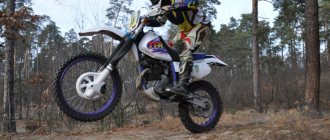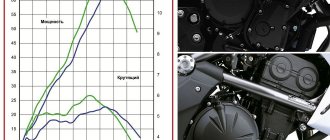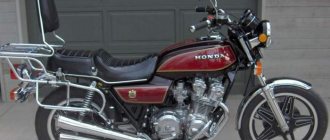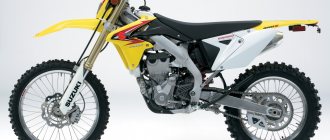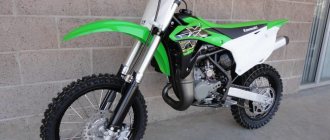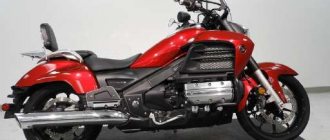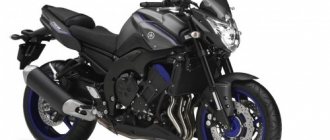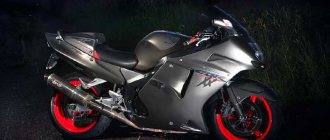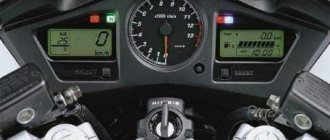| Yamaha R6 (1999-2002) | Yamaha R6 (2003-2004) | Yamaha R6 (2005) | Yamaha R6 (2006-2007) |
| Yamaha R6 (2008-2009) | Yamaha R6 (2010-2016) | Yamaha R6 (2017+) |
Yamaha R6 (YZF-R6) sports motorcycle model
appeared on the market in 1998 (1999 model year) as a successor to the Yamaha YZF600R Thundercat (which was also produced at the same time, but positioned itself as a sports tourer) and as a junior version of the Yamaha R1 (YZF-R1).
The basis was a new engine with a volume of about 600 cm³, liquid cooling, producing up to 120 hp. Compared to the Thundercat, the engine has become shorter stroke, has forged pistons with a low coefficient of friction, a new crankshaft, connecting rods, ignition system, two-pin spark plugs and Mikuni carburetors with a throttle position sensor.
In 2001, the Yamaha R6 engine received minor changes that affected the connecting rods, pistons, exhaust system, ignition system and battery (a slightly lighter one with a smaller capacity began to be installed).
In 2003, the model underwent its first major restyling. The appearance of the plastic and the headlight changes, the wheels become 5-beam. The updated model receives an injector instead of a carburetor, which led to a noticeable increase in traction in the low and medium speed zone, although the maximum power remained at the same level - 120 hp. New generation of Deltabox frame. Curb weight is reduced by 6 kg.
In 2005, the Yamaha YZF-R6 model is changing again. The motorcycle is equipped with a 41 mm inverted fork and radial calipers, the diameter of the front brake discs increases: 298 → 310 mm. As for the engine, the model receives modified intake and exhaust systems (the diameter of the exhaust manifold has been increased to 40 mm). The front tire size changes: 120/60ZR17 (55W) → 120/70ZR17 M/C (58W).
A year later, in 2006, the Yamaha YZF-R6 undergoes another major restyling. The appearance of the plastic, headlights and exhaust system changes. The model receives a new engine with inertial supercharging, producing up to 127 hp. (122 hp - naturally aspirated). The fuel tank capacity increases: 17.0 → 17.5 l. The model also receives an electronic throttle (YCC-T - Yamaha Chip Controlled Throttle) and an injection system with dual injectors (Mikuni 40EIS → Mikuni 41EIDW). The gearbox ratios change, the clutch gets a slip function. The motorcycle gets a new ignition system (DC CDI → TCI). The engine receives titanium valves, lightweight forged pistons, a titanium exhaust system with EXUP valves, and a lightweight flywheel.
In 2008, the model changes again, although visually it is very similar to the previous generation. The fuel tank capacity decreases slightly: 17.5 → 17.3 l. The engine increases the compression ratio: 12.8 → 13.1. Maximum power increases to 129 hp. (with inertial supercharging). The model receives a system with automatically variable intake manifold length - YCC-I (Yamaha Chip Controlled Intake).
2010 was marked by another small restyling of the Yamaha YZF-R6 model. The model receives an updated appearance, a new engine management program and a new exhaust. Curb weight is 189 kg. Maximum engine power is 123.8 hp.
For 2021, the motorcycle changes again, taking on the visual cues of the new Yamaha R1. The model is equipped with a 43 mm inverted fork, a new rear shock absorber, a new braking system (increased to 320 mm brake discs, ABS), an aluminum fuel tank, a magnesium subframe and a new aerodynamic system (reduces air resistance by 8%). New electronic systems have appeared: TCS (Traction Control System) and D-Mode (Selectable Drive Mode). Maximum power is 118.4 hp. Curb weight - 190 kg.
Yamaha R6: electronic assistants
- YCC-T (Yamaha Chip Controlled Throttle) - since 2006
- YCC-I (Yamaha Chip Controlled Intake) - since 2008
- ABS - from 2021
- TCS (Traction Control System) - from 2021
- D-Mode (Selectable Drive Mode) - from 2021
- QSS (Quick Shifter System) up - from 2021
The main competitors of the Yamaha R6 in the class:
- Honda CBR600RR
- Suzuki GSX-R600
- Kawasaki ZX-6R
Brief history of the model
- 1999 - start of production and sales. First generation
.
Model
: Yamaha YZF-R6 (Europe, North America, Australia).
Factory designation
: 5GV1, 5GV2, 5GV3, 5EB1, 5EB2, 5EB3.
- 2000 - no significant changes.
Model
: Yamaha YZF-R6 (Europe, North America, Australia).
Factory designation
: 5GV4, 5GV5, 5GV6, 5EB5, 5EB6, 5EB7, 5EB8.
- 2001 - minor changes to the model (described in detail at the beginning of the review).
Model
: Yamaha YZF-R6 (Europe, North America, Australia).
Factory designation
: 5MT1, 5MT2, 5MT3, 5MT4, 5MT6, 5MT7, 5MT8, 5MT9, 5MTA.
- 2002 - no significant changes.
Model
: Yamaha YZF-R6 (Europe, North America, Australia).
Factory designation
: 5MTB, 5MTC, 5MTD, 5MTE, 5MTF, 5MTG, 5MTH.
- 2003 - restyling of the model. Second generation
.
Model
: Yamaha YZF-R6 (Europe, North America, South Africa, Australia).
Factory designation
: 5SL1, 5SL2, 5SL3, 5SL4, 5SL5, 5SL7, 5SL8, 5SL9.
- 2004 - no significant changes.
Model
: Yamaha YZF-R6 (Europe, North America, South Africa, Australia).
Factory designation
: 55SLB, 5SLC, 5SLD, 5SLE, 5SLF, 5SLH, 5SLJ.
- 2005 - restyling of the model. Third generation
.
Model
: Yamaha YZF-R6 (Europe, North America, Japan, Australia).
Factory designation
: 5SLS, 5SLR, 5SLW, 5SLV, 5SLX, 5SLN, 5SLM, 5SLP, 5SLT, 5SLU.
- 2006 - restyling of the model. Fourth generation
.
Model
: Yamaha YZF-R6 (Europe, North America, Japan, Australia).
Factory designation
: 4P61, 4P62, 4P63, 2C01, 2C02, 2C03, 2C05, 2C06, 2C07, 2C08, 2C09, 2C0A.
- 2007 - no significant changes.
Model
: Yamaha YZF-R6 (Europe, North America, Japan, Australia).
Factory designation
: 4P64, 4P65, 4P66, 2C0B, 2C0C, 2C0D, 2C0F, 2C0G, 2C0H.
- 2008 - restyling of the model. Fifth generation.
Model
: Yamaha YZF-R6 (Europe, North America, Japan, Australia).
Factory designation
: 4P68, 4P69, 13S1, 13S2, 13S4, 13S5, 13S6, 13S8, 13S9, 13SA.
- 2009 - no significant changes.
Model
: Yamaha YZF-R6 (Europe, North America, Japan, Australia).
Factory designation
: 4P6A, 4P6B, 4P6C, 13SB, 13SC, 13SH, 13SJ, 13SK, 13SG, 13SM.
- 2010 - restyling of the model. Sixth generation.
Model
: Yamaha YZF-R6 (Europe, North America, Japan, Australia).
Factory designation
: 13SL, 13SR, 13SS, 13ST, 13SU.
- 2011 - no significant changes.
Model
: Yamaha YZF-R6 (Europe, North America, Japan, Australia).
Factory designation
: 13SV, 1JS5, 1JS1, 1JS6, 1JS2, 1JS7, 1JS3, 1JS8.
- 2012 - no significant changes.
Model
: Yamaha YZF-R6 (Europe, North America, Australia).
Factory designation
: 1JSL, 1JSG, 1JSP, 1JSR, 1JSD, 1JSA, 1JSE, 1JSB, 1JSS, 1JSF, 1JSC, 1JSL.
- 2013 - no significant changes.
Model
: Yamaha YZF-R6 (Europe, North America, Australia).
Factory designation
: 1JSU, 1JSV, 2CX1, 2CX2, 2CX3.
- 2014 - no significant changes.
Model
: Yamaha YZF-R6 (Europe, North America, Australia).
Factory designation
: 2CXB, 2CX4, 2CX9, 2CX7, 2CX8.
- 2015 - no significant changes.
Model
: Yamaha YZF-R6 (Europe, North America, Australia).
Factory designation
: 2CXE, 2CXL, 2CXJ, 2CXK.
- 2016 - no significant changes.
Model
: Yamaha YZF-R6 (Europe, North America, Japan, Australia).
Factory designation
: 1JSY, 2CXM, 2CXY, 2CXU, 2CXW, 2CXX, 2CXS, 2CXT.
- 2017 - restyling of the model. Seventh generation
.
Model
: Yamaha YZF-R6 (Europe, North America, Australia).
Factory designation
: BN64, BN63, BN61, BN62.
- 2018 - no significant changes.
Model
: Yamaha YZF-R6 (Europe, North America, Japan, Australia).
Factory designation
BN6A, BN6D
- 2019 - no significant changes.
Model
: Yamaha YZF-R6 (Europe, North America, Australia, Japan).
- 2020 - no significant changes.
Model
: Yamaha YZF-R6 (Europe, North America, Australia, Japan).
- 2021 - no significant changes.
Model
: Yamaha YZF-R6 (Europe, North America, Australia, Japan).
Specifications
Yamaha YZF-R1 Specifications:
| Model | Yamaha R1 (YZF-R1) |
| Motorcycle type | sport |
| Year of issue | 1998+ |
| Frame | aluminum Deltabox |
| engine's type | 4-cylinder, 4-stroke, in-line Crossplane (90° cranks) crankshaft – R1 (2009+) |
| Working volume | 998 cm³ |
| Bore/Stroke | 74.0 x 58.0 mm – R1 (1998-2003) 77.0 x 53.6 mm – R1 (2004-2008) 78.0 x 52.2 mm – R1 (2009-2014) 79.0 x 50.9 mm – R1 (2015+) |
| Compression ratio | 11.8:1 – R1 (1998-2003) 12.4:1 – R1 (2004-2006) 12.7:1 – R1 (2007-2014) 13.0:1 – R1 (2015+) |
| Cooling | liquid |
| Number of valves per cylinder | DOHC, 5 valves per cylinder – R1 (1998-2006) DOHC, 4 valves per cylinder – R1 (2007+) |
| Fuel supply system | Carburetor, 4x Mikuni BDSR40 – R1 (1998-2001) Injector, 4x Mikuni 40EIS – R1 (2002-2003) Injector, Mikuni 45EIDW – R1 (2004+) YCC-I (Yamaha Chip Control Intake) – R1 (2007+) YCC-T (Yamaha Chip Control Throttle) – R1 (2007+) |
| Ignition type | TCI |
| Maximum power | 150.0 hp (110.0 kW) at 10,000 rpm – R1 (1998-2001) 152.0 hp (112.0 kW) at 10500 rpm – R1 (2002-2003) 172.0 hp (126.0 kW) at 12500 rpm – R1 (2004-2005) 175.0 hp (129.0 kW) at 12500 rpm – R1 (2006) 180.0 hp (132.0 kW) at 12500 rpm – R1 (2007-2008) 182.0 hp (134.0 kW) at 12500 rpm – R1 (2009-2014) 200.0 hp (147.0 kW) at 13500 rpm – R1 (2015+) |
| Maximum torque | 108.0 Nm (11.0 kg*m) at 8500 rpm – R1 (1998-2001) 105.0 Nm (11.0 kg*m) at 8500 rpm – R1 (2002-2003) 107.0 Nm (11.0 kg*m) at 10500 rpm – R1 (2004-2006) 113.0 Nm (11.5 kg*m) at 10,000 rpm – R1 (2007-2008) 116.0 Nm (12.0 kg*m) at 10,000 rpm – R1 (2009-2014) 112.0 Nm (11.5 kg*m) at 11500 rpm – R1 (2015-2019) 113.3 Nm (11.6 kg*m) at 11500 rpm – R1 (2020+) |
| Clutch | Multi-disc in oil bath, cable drive |
| Transmission | 6-speed |
| type of drive | chain |
| Front tire size | 120/70ZR17 M/C (58W) |
| Rear tire size | 190/50 ZR17 (73W) – R1 (1998-2000) 190/55 ZR17 M/C (75W) – R1 (2009+) 200/55 ZR17 M/C (78W) – R1M |
| Front brakes | 2 discs, 298 mm, 4-piston calipers – R1 (1998-2003) 2 discs, 320 mm, 4-piston radial calipers – R1 (2004-2006) 2 discs, 310 mm, 6-piston radial calipers – R1 (2007-2014) 2 discs, 320 mm, 4-piston radial calipers (combined UBS – Unified Brake System + ABS) – R1 (2015+) |
| Rear brakes | 1 disc, 245 mm, 2-piston caliper – R1 (1998-2001) 1 disc, 220 mm, 2-piston caliper – R1 (2002-2003) 1 disc, 220 mm, 1-piston caliper – R1 (2004+) (2015+: combination UBS – Unified Brake System + ABS) |
| Front suspension | 41mm inverted telescopic fork (fully adjustable), 135mm travel - R1 (1998-2001) 43mm inverted telescopic fork (fully adjustable), 120mm travel - R1 (2002+) Öhlins electronic semi-active suspension – R1M |
| Rear suspension | Pendulum with monoshock absorber (fully adjustable), stroke – 130 mm – R1 (1998-2008) Pendulum with monoshock absorber (fully adjustable), travel – 120 mm – R1 (2009+) Öhlins electronic semi-active suspension – R1M |
| Length | 2035 mm – R1 (1998-2001) 2040 mm – R1 (2002-2003) 2065 mm – R1 (2004-2005) 2085 mm – R1 (2006) 2060 mm – R1 (2007-2008) 2070 mm – R1 (2009-2014) 2055 mm – R1 (2015+) |
| Width | 695 mm – R1 (1998-2001) 705 mm – R1 (2002-2003) 720 mm – R1 (2004-2008) 715 mm – R1 (2009-2014) 690 mm – R1 (2015+) |
| Height | 1095 mm – R1 (1998-1999) 1105 mm – R1 (2000-2006) 1110 mm – R1 (2007-2008) 1130 mm – R1 (2009-2014) 1150 mm – R1 (2015+) |
| Wheelbase | 1395 mm – R1 (1998-2006) 1415 mm – R1 (2007-2014) 1405 mm – R1 (2015+) |
| Minimum ground clearance (clearance) | 140 mm – R1 (1998-2003) 135 mm – R1 (2004-2014) 130 mm – R1 (2015+) |
| Seat height | 815 mm – R1 (1998-2001) 820 mm – R1 (2002-2003) 835 mm – R1 (2004-2014) 855-860 mm – R1 (2015+) |
| Acceleration to 100 km/h | 2.88 sec |
| Maximum speed | 293 km/h |
| Gas tank capacity | 18.0 l (including reserve - 5.5 l) - R1 (1998-1999) 18.0 l (including reserve - 3.8 l) - R1 (2000-2001) 17.0 l (including reserve - 3.3 l) - R1 (2002-2003) 18.0 l (including reserve - 3.4 l) - R1 (2004-2006) 18.0 l (including reserve - 3.2 l) - R1 (2007-2008) 18.0 l (including reserve - 3.1 l) - R1 (2009-2014) 17.0 l (including reserve – 3.0 l) – R1 (2015+) |
| Motorcycle weight (curb) | 198 kg – R1 (1998-1999) 194 kg – R1 (2000-2001, 2006) 193 kg – R1 (2002-2005) 200 kg – R1 (2007-2008, 2015+) 206 kg – R1 (2009-2014) |
Reviews
Reviews about Yamaha R6 (YZF-R6):
Expand Collapse
A device for catapulting organic beings in space. the car is amazing and, having a normal head and skills, will give you those emotions that no other car can give. Not like the first spendthrift.
The best of 600! The brakes are excellent, steering is easy, it’s very comfortable in the city, but I’ll say right away that a very rigid motorcycle is more suitable for the track. I have almost nothing in terms of tuning, xenon low beam, sliders, tinted glass... there are a lot of things that can be modified for those who like to fool around, I bought it for the season so I didn’t invest.... I've driven about 5 thousand this season already, changed the oil and filters, tires from Dunlop to Pirelli, the difference is colossal... Dunlop is oak, I put it back 190. Who will say that it's technically not recommended, it's complete nonsense, I drive it, put it up to the feet and don't throw it out anywhere. I accelerated to a little over 270, maybe more was possible, but there was room, I only drive around the city and to the nearest Moscow region. As for reliability, I can’t say yet, but there are no problems, I’ve been driving normally for 7 years now, so I burn normally at times, and it doesn’t burn oil. In general, it may help someone when choosing. Use brake fluid 5.1, it heats up less, don’t skimp on tires and pads, oil every 2-3 thousand, in general, keep an eye on the condition, the motorcycle does not forgive mistakes and negligence, ALWAYS wear an outfit, preferably a full one, you only have one life, so take care of it.
The bike is excellent - for those who love a beautiful and aggressive sporty design and good dynamics, as well as reliability and ease of fit (for sports - this is very rare) the YZF R6 03-05 model, as well as the R6S produced before 2008, are essentially one and the same too, only the 2005 model has an inverted fork... this sportbike was simply born for the urban jungle, and it’s also quite comfortable to ride long distances... there were never any problems in those areas, I’m the 3rd owner, I rode for 2 seasons, I only changed consumables, total mileage about 40 thousand... these models easily go up to 100 thousand and more... it all depends on the operation, it doesn’t consume oil at all, consumption = a full tank of 95 (with beep) for 220 km (including reserve)... in the city you can easily make any liter... Because 200 liters don’t drive around the city and they are significantly inferior in maneuverability, the p6 steers like a bicycle = very comfortable, and up to 200 acceleration is like a liter, maximum speed is 260-270
YZF-R6 2005 is now perceived as a semi-tourist. The motorcycle is generally cool, but parts are rare. You'll get tired of looking for spare parts. In general, the motorcycle is reliable. The steering is not very nervous and sharp. Compared to the 2005 Siberian, it loses in taxiing. The ass wears out from intense braking. Cylinder heads are a weak point. They fell, fucked up, asshole.
YZF R6 2008-2010 — I liked literally everything. It steers sharply. Reacts quickly to the pilot's slightest wishes. The brakes simply bite into the asphalt (you need to be careful with them, the 2005-06 Honda is very forgiving when braking), but for experienced pilots this is a plus. Doesn't carry his ass during active braking. The engine is peppy. But twitchy. You need to be as careful as possible in the rain and when turning at large angles. I was pleased with the suspension - it works at 148%! =) Motik is a professional butterfly handler. Girls are thirsty. The plastic is beautiful on the outside, but in fact it's fragile as hell. What a JING Dynasty Vase! A non-repairable expensive toy that GOES! And how it goes. Let's just say... thanks to the duet of the engine and chassis, you have every chance to show the owners of liters your brake light. =) In the city... in a traffic jam... =)
Description of the Yamaha YZF-R6 sportbike
A detailed analysis of the characteristics of the Yamaha YUZF R6 bike can be studied below.
Maximum speed and acceleration
The Yamaha P6 accelerates to 100 km/h in 3.2 seconds. The maximum speed of the Yamaha P6 is 277 km/h.
Design Features
The motorcycle is made in the classic style of Japanese sports bikes. Featuring a fetal-shaped fit for maximum streamlining.
Stylish design
The appearance of the Yamaha P6 sportbike is quite aggressive and characteristic of such motorcycles.
Weight and dimensions
The weight of the Yamaha P6 is 166 kg, its length is 204 cm, width – 70.5, height – 110 cm.
The motorcycle is made in the classic style of Japanese sports bikes
Specifications
By releasing the 600cc and 1000cc models in parallel, Yamaha engineers applied the most advanced technologies to both of them. The bike turned out to be not only balanced, but also incredibly powerful, and its technical characteristics can put almost anyone to shame. If compromises are not your thing, but a liter sportbike seems too big and heavy for you, the Yamaha YZF R6 will be the perfect option for you.
Engine
The engine that was originally installed in 2001 was slightly modified, and then acquired an injector along with four carburetors. Subsequently, it was modernized several more times, receiving an inertial charging system that adds power at high speed, different operating modes and an increased compression ratio. At the same time, the power ultimately did not increase, but even decreased slightly - in the first generation it is 120 hp, and in the last - 118.4 hp, and it is achieved at around 13000-14500 rpm. Torque ranges from 68 to 61 Nm, it is available at 10500-12500 rpm, so the engine needs to be constantly revved. Acceleration to 100 km/h takes only 3 seconds! At the same time, the maximum speed of the R6 is only slightly inferior to that of the YZF-R1, officially amounting to 260 km/h.
Transmission
The modern 6-speed transmission with slipper clutch works perfectly, shifting gears is easy and very precise. At the same time, the gearbox foot has a short stroke, which may at first seem unusual for motorcyclists who have switched from another vehicle. And it’s worth keeping in mind that the YZF-R6 is more demanding when it comes to choosing the right gear than the YZF-R1. After all, how many cubes do they both have? That’s the difference - with a smaller volume, the engine has to be turned more actively, and the gearbox has to be worked more often.
Chassis and brakes
The alloy Deltabox frame with a lightweight swingarm has been changed several times, but on any generation of the motorcycle it is completely consistent with its time. The suspension is fully adjustable both front and rear, and since 2005 an inverted fork has been installed. The brakes are very grippy; the front wheel has two discs (from 298 to 320 mm) with 4-piston calipers, and the rear wheel has another 220 mm disc with a 1-piston caliper (on older models, with a 2-piston caliper). ABS is only available on motorcycles 2021 and younger.
Electronics
Older copies have little electronic filling, but the younger the bike, the more there is. Starting in 2021, there are even more electronics due to the addition of auxiliary traction control systems and selection of engine operating modes. For diagnostics, you need to connect the motorcycle to a laptop with special software via the CAN bus.
Weight and dimensions
The curb weight ranges from 182 to 190 kg, but in any case remains low. Despite its not too low center of gravity, the R6 doesn't feel heavy and is very easy to handle. The compact dimensions also make a positive contribution, thanks to which the bike feels like a fish in water in dense city traffic.
Controllability
All generations of the Yamaha R6 handle superbly, and in the city they feel even more confident than the “liter” ones, thanks to their more modest dimensions and comparable dynamics. In reviews and feedback from owners, complaints arise only about the 2005-2006 models, which, according to pilots, have a tendency to skid the rear wheel during sudden braking.
Fuel consumption
This parameter directly depends on the year of manufacture (more precisely, on the generation) of the motorcycle, its technical condition, operating conditions and riding style. Modern injection R6s from 2018 consume an average of 5.6 liters per 100 km, and for some R6 from 2003 this parameter will be a liter and a half more, especially if you drive aggressively. Tank volume is from 17 to 17.5 liters, depending on the generation.
Repair and tuning
How often you will have to spend money on your two-wheeled friend, and how much money will be spent, greatly depends on the operating conditions of the motorcycle. If you drive as usual, then you will spend less, but with regular races on the track, repairs and maintenance will require completely different amounts.
Repair
The Yamaha YZF R6 is not highly maintainable, and many components in it, in the event of a breakdown, can only be replaced and not repaired. This results in the high cost of maintaining the model and the complexity of many service operations. In addition, the latest generations of sport bikes contain a lot of complex electronics, which only experienced mechanics with a laptop and special software can understand. To carry out full diagnostics, you need to connect the “brains” of the bike to a computer and analyze all the data.
Spare parts
The compatibility of spare parts between different generations of a motorcycle is far from 100%, and it is often difficult to find the necessary parts for old Yamaha YuZF R 6. Everything is available to order, but the price may surprise you. But there are few non-original spare parts, despite the popularity of the model and the fact that the market is full of non-original consumables. Their quality ranges from excellent to dismal.
Tuning
The range of available tuning is huge, it includes both cosmetic elements and purely technical ones. Refining the transmission, strengthening the engine, upgrading the brakes - whatever you want, there would be enough money. Moreover, most of this stuff is offered by third-party manufacturers, and not by Yamaha itself.
Specifications
Let's briefly look at the main technical characteristics of the Yamaha R6.
Fuel consumption
The bike consumes from 6 to 8 liters of fuel per 100 km. How many cubes a Yamaha P6 has depends on the year of manufacture. Most models are equipped with a 600 cc engine. cm.
engine's type
The bike is equipped with a 4-cylinder, 4-stroke engine with a power of 127 hp. With. and torque of 10,500 rpm.
Transmission
The gearbox is mechanical, 6-speed with chain drive. Since 2006 it has also been equipped with a slipper clutch.
Disc brakes allow you to achieve high speeds without risk.
Chassis and brakes
Disc brakes allow you to reach high speeds with confidence without risk. The front has two discs with 4 pistons, the rear has only one disc and a 2-piston caliper (until 2002).
Suspension
The rear suspension is pendulum with 120 mm travel and a monoshock absorber. The front one is telescopic, fully adjustable, inverted in models starting from 2005.
